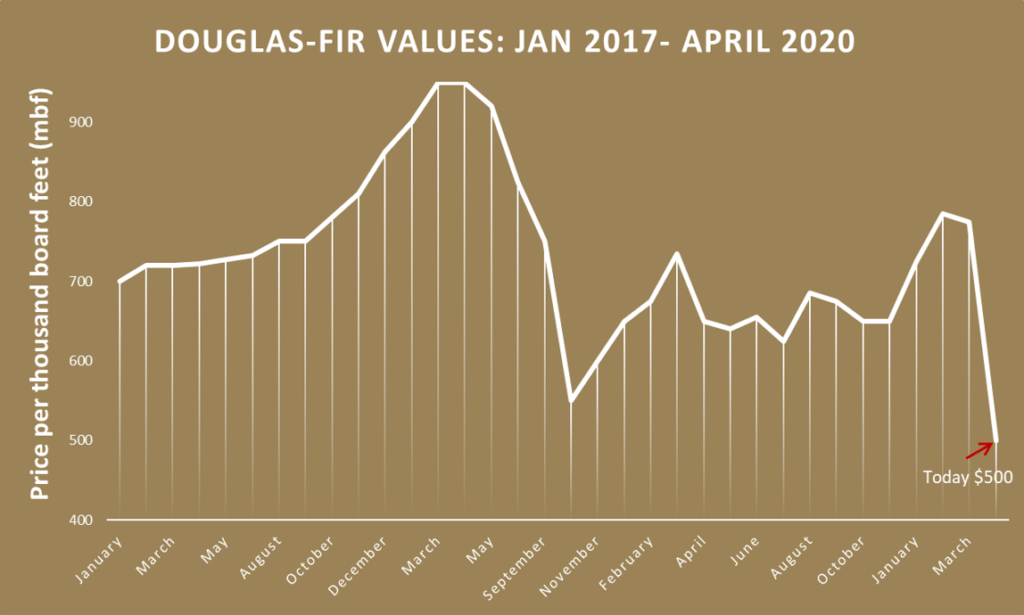By Lauren Grand, OSU Extension Forestry & Natural Resources Agent, Lane County
Everyone said it would happen, that we were “due,” but we just didn’t know how or when. Well, it’s finally here. The arrival of the coronavirus has caused our economy to become recessed. While the country deems all aspects of forestry and the forest industry an essential service, it has not been protected from these uncertain times.
Normally, this time of year, I would be telling you that prices were on the rise coming out of January to their peak in March and April. Then, they take their slow decent through the summer as more wood becomes available. However, we have another abnormal year on our hands. In 2017 and 2018 it was good news. Prices were on the rise and higher than they have ever been. This year, prices are way down if you can find a buyer.
The coronavirus has caused so much uncertainty in the market that consumers, builders, remodelers, etc. would rather hold on to cash than purchase inventory of finished wood products. Along with “stay at home” orders around the country wood products are hardly flying off the shelves. Too bad we don’t make much toilet paper around here. This lack of purchasing has affected everyone up the supply chain and now we have a surplus of wood and the summer hasn’t even started.
At the time this article is being written, mid-April, most log buyers are being extremely conservative writing new purchase orders. They either don’t have new contracts in or are looking for ways to honor the purchase orders they have already written. There are some still buying, however, prices are in the $500 per thousand board foot range for Douglas-fir and $400 per thousand foot range for the Hem-fir logs. Hardly seems worth it when prices have averaged over $600 per thousand for Douglas-fir since 1995 in a normal summer.

If harvesting is on your to-do list this summer and you are lucky enough to have some poles at harvesting size, then poles may be able to offer you some relief. While the pole market has significantly slowed down and become more selective, their prices are more exciting than sawlogs. The volatility of the market has these prices changing frequently, but at the time of this article prices for short poles are fetching $750-$800 per thousand and $975-$1025 for long poles. Looks good compared to the $500 per thousand mentioned above, but these prices are still $100-$200 less than previous reports around this time. Note that if you are selling during this time you may have to deal with more constrained deliveries per week.
Cedar also seems to be doing alright. With all the time at home people must be fixing their fences, decks, and finding other projects around the house. This has kept a demand for cedar, but pricing has come off a bit. Western redcedar is $750 – $800 per thousand, incense cedar is $600-$700 per thousand, and Port-Orford-Cedar is in the $500-$550 per thousand range.
During the stay at home order, I hope many of you are able to enjoy some extra time on your property. Maybe you’ll even be interested in starting a new hobby that can bring you some added income. Some non-timber forest product companies are still purchasing during this time because they still have contracts to fulfill and these products are often seasonal. Additionally, harvesters are having trouble getting permits with BLM and Forest Service offices being closed. This could be the perfect opportunity to capitalize on the situation. Currently, the ol’ standbys of Oregon grape and usnea lichen are still being purchased. Oregon grape is selling for around $0.70 a pound green. It’s best to get the product to your buyer within 2-3 days from harvest. There is a premium for certified organic. Usnea lichen is still sitting pretty at $5.50 per clean and dry pound. Cascara bark is also currently being purchased and will fetch you $0.45 green and $1.20 “potato chip” dry. Buyers are also looking for cones and it is morel season!
As the log market demonstrates uncharted volatility from week to week during the coronavirus crisis, my recommendation is if you can wait, then hold off on any harvesting until the market starts to look more favorable. In the meantime, now is a good time to dust off your management plan and start get your ducks in a row, in preparation for more certain times. If you are still interested in harvesting, or have a salvage project you have to do, then call around. The buyers are answering their phones and the market is so volatile that everything changes week by week, even day by day. You might find a buyer with the price you are looking for. Hang tight, we’ll get through this hiccup and hopefully see strong prices again soon.


